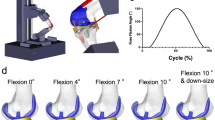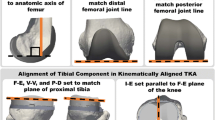Abstract
Purpose
Abnormal knee motion under various conditions has been described after total knee arthroplasty (TKA). However, differences in kinematics and kinetics of knees with varus femoral versus varus tibial alignment have not been evaluated. It was hypothesized that varus femoral and tibial alignments have the same impact on knee motion.
Methods
A musculoskeletal computer simulation was used. Femoral and tibial alignment in the coronal plane was each varied from neutral to 5° of varus in 1° increments. Lift-off, defined as an intercomponent distance of >2 mm, and tibiofemoral contact forces were evaluated during gait up to 60° of knee flexion. Knee kinematics and contact stresses were also examined during squat, with up to 130° of knee flexion.
Results
During gait, lift-off occurred readily with more than 3° of varus tibial alignment and slight lateral joint laxity. In contrast, lift-off did not occur with varus femoral or tibial alignment of up to 5° during squat. Peak medial contact forces with varus femoral alignment were approximately twice those observed with varus tibial alignment. The lowest points of the femoral condyles moved internally with varus femoral alignment, contrary to the kinematics with neutral or varus tibial alignment. On the other hand, there was femoral medial sliding and edge loading against the tibia in mid-flexion with varus tibial alignment.
Conclusion
Varus femoral alignment affects the non-physiological rotational movement of the tibiofemoral joint, whereas varus tibial alignment causes medial–lateral instability during mid-flexion. Varus femoral and tibial alignments might lead to post-TKA discomfort and unreliability.





Similar content being viewed by others
References
Belvedere C, Ensini A, Feliciangeli A, Cenni F, D’Angeli V, Giannini S, Leardini A (2012) Geometrical changes of knee ligaments and patellar tendon during passive flexion. J Biomech 45:1886–1892
Blankevoort L, Kuiper JH, Huiskes R, Grootenboer HJ (1991) Articular contact in a three-dimensional model of the knee. J Biomech 24:1019–1031
D’Lima DD, Patil S, Steklov N, Chien S, Colwell CW Jr (2007) In vivo knee moments and shear after total knee arthroplasty. J Biomech 40(Suppl 1):S11–S17
Dennis DA, Komistek RD, Walker SA, Cheal EJ, Stiehl JB (2001) Femoral condylar lift-off in vivo in total knee arthroplasty. J Bone Joint Surg Br 83:33–39
Gromov K, Korchi M, Thomsen MG, Husted H, Troelsen A (2014) What is the optimal alignment of the tibial and femoral components in knee arthroplasty? Acta Orthop 85:480–487
Halewood C, Risebury M, Thomas NP, Amis AA (2014) Kinematic behaviour and soft tissue management in guided motion total knee replacement. Knee Surg Sports Traumatol Arthrosc 22:3074–3082
Hamai S, Miura H, Okazaki K, Shimoto T, Higaki H, Iwamoto Y (2014) No influence of coronal laxity and alignment on lift-off after well-balanced and aligned total knee arthroplasty. Knee Surg Sports Traumatol Arthrosc 22:1799–1804
Innocenti B, Pianigiani S, Labey L, Victor J, Bellemans J (2011) Contact forces in several TKA designs during squatting: a numerical sensitivity analysis. J Biomech 44:1573–1581
Ishikawa M, Kuriyama S, Ito H, Furu M, Nakamura S, Matsuda S (2015) Kinematic alignment produces near-normal knee motion but increases contact stress after total knee arthroplasty: a case study on a single implant design. Knee 22:206–212
Kawahara S, Okazaki K, Matsuda S, Nakahara H, Okamoto S, Iwamoto Y (2014) Internal rotation of femoral component affects functional activities after TKA—survey with the 2011 Knee Society Score. J Arthroplasty 29:2319–2323
Keshmiri A, Springorum HR, Baier C, Zeman F, Grifka J, Maderbacher G (2016) Changes in sagittal component alignment alters patellar kinematics in TKA: an in vitro study. Knee Surg Sports Traumatol Arthrosc 24:823–829
Kuriyama S, Ishikawa M, Furu M, Ito H, Matsuda S (2014) Malrotated tibial component increases medial collateral ligament tension in total knee arthroplasty. J Orthop Res 32:1658–1666
Kuriyama S, Ishikawa M, Nakamura S, Furu M, Ito H, Matsuda S (2015) Posterior tibial slope and femoral sizing affect posterior cruciate ligament tension in posterior cruciate-retaining total knee arthroplasty. Clin Biomech (Bristol, Avon) 30:676–681
Kuriyama S, Ishikawa M, Nakamura S, Furu M, Ito H, Matsuda S (2016) No condylar lift-off occurs because of excessive lateral soft tissue laxity in neutrally aligned total knee arthroplasty: a computer simulation study. Knee Surg Sports Traumatol Arthrosc 24:2517–2524
Kurtz SM, Muratoglu OK, Evans M, Edidin AA (1999) Advances in the processing, sterilization, and crosslinking of ultra-high molecular weight polyethylene for total joint arthroplasty. Biomaterials 20:1659–1688
LaPrade RF, Bollom TS, Wentorf FA, Wills NJ, Meister K (2005) Mechanical properties of the posterolateral structures of the knee. Am J Sports Med 33:1386–1391
Liu F, Gadikota HR, Kozánek M, Hosseini A, Yue B, Gill TJ, Rubash HE, Li G (2011) In vivo length patterns of the medial collateral ligament during the stance phase of gait. Knee Surg Sports Traumatol Arthrosc 19:719–727
Liu HX, Shang P, Ying XZ, Zhang Y (2015) Shorter survival rate in varus-aligned knees after total knee arthroplasty. Knee Surg Sports Traumatol Arthrosc 24:2663–2671
Mandeville D, Osternig LR, Lantz BA, Mohler CG, Chou LS (2008) The effect of total knee replacement on the knee varus angle and moment during walking and stair ascent. Clin Biomech (Bristol, Avon) 23:1053–1058
Matsuzaki T, Matsumoto T, Kubo S, Muratsu H, Matsushita T, Kawakami Y, Ishida K, Oka S, Kuroda R, Kurosaka M (2014) Tibial internal rotation is affected by lateral laxity in cruciate-retaining total knee arthroplasty: an intraoperative kinematic study using a navigation system and offset-type tensor. Knee Surg Sports Traumatol Arthrosc 22:615–620
Meijer MF, Boerboom AL, Bulstra SK, Reininga IH, Stevens M (2016) Do CAS measurements correlate with EOS 3D alignment measurements in primary TKA? Knee Surg Sports Traumatol Arthrosc. doi:10.1007/s00167-016-4031-3
Mizu-Uchi H, Colwell CW Jr, Flores-Hernandez C, Fregly BJ, Matsuda S, D’Lima DD (2015) Patient-specific computer model of dynamic squatting after total knee arthroplasty. J Arthroplasty 30:870–874
Moro-oka TA, Shiraishi H, Iwamoto Y, Banks SA (2010) Modified gap-balancing technique in total knee arthroplasty: evaluation of the post-operative coronal laxity. Knee Surg Sports Traumatol Arthrosc 18:375–380
Mullaji AB, Shetty GM (2013) Surgical technique: computer-assisted sliding medial condylar osteotomy to achieve gap balance in varus knees during TKA. Clin Orthop Relat Res 471:1484–1491
Nakahara H, Okazaki K, Hamai S, Okamoto S, Kuwashima U, Higaki H, Iwamoto Y (2014) Does knee stability in the coronal plane in extension affect function and outcome after total knee arthroplasty? Knee Surg Sports Traumatol Arthrosc 23:1693–1698
Nakamura S, Tian Y, Tanaka Y, Kuriyama S, Ito H, Furu M, Matsuda S (2017) The effects of kinematically aligned total knee arthroplasty on stress at the medial tibia: a case study for varus knee. Bone Joint Res 6:43–51
Nishikawa K, Okazaki K, Matsuda S, Tashiro Y, Kawahara S, Nakahara H, Okamoto S, Shimoto T, Higaki H, Iwamoto Y (2014) Improved design decreases wear in total knee arthroplasty with varus malalignment. Knee Surg Sports Traumatol Arthrosc 22:2635–2640
Okamoto S, Okazaki K, Mitsuyasu H, Matsuda S, Iwamoto Y (2013) Lateral soft tissue laxity increases but medial laxity does not contract with varus deformity in total knee arthroplasty. Clin Orthop Relat Res 471:1334–1342
Pandit H, van Duren BH, Price M, Tilley S, Gill HS, Thomas NP, Murray DW (2013) Constraints in posterior-stabilised TKA kinematics: a comparison of two generations of an implant. Knee Surg Sports Traumatol Arthrosc 21:2800–2809
Park SE, DeFrate LE, Suggs JF, Gill TJ, Rubash HE, Li G (2005) The change in length of the medial and lateral collateral ligaments during in vivo knee flexion. Knee 12:377–382
Paternostre F, Schwab PE, Thienpont E (2014) The difference between weight-bearing and non-weight-bearing alignment in patient-specific instrumentation planning. Knee Surg Sports Traumatol Arthrosc 22:674–679
Robinson JR, Bull AM, Amis AA (2005) Structural properties of the medial collateral ligament complex of the human knee. J Biomech 38:1067–1074
Stiehl JB, Komistek RD, Dennis DA (1999) Detrimental kinematics of a flat on flat total condylar knee arthroplasty. Clin Orthop Relat Res 365:139–148
Stiehl JB, Komistek RD, Dennis DA, Paxson RD, Hoff WA (1995) Fluoroscopic analysis of kinematics after posterior-cruciate-retaining knee arthroplasty. J Bone Joint Surg Br 77:884–889
Sugita T, Amis AA (2001) Anatomic and biomechanical study of the lateral collateral and popliteofibular ligaments. Am J Sports Med 29:466–472
Tanaka Y, Nakamura S, Kuriyama S, Ito H, Furu M, Komistek RD, Matsuda S (2016) How exactly can computer simulation predict the kinematics and contact status after TKA? Examination in individualized models. Clin Biomech 39:65–70
van Duren BH, Pandit H, Beard DJ, Zavatsky AB, Gallagher JA, Thomas NP, Shakespeare DT, Murray DW, Gill HS (2007) How effective are added constraints in improving TKR kinematics? J Biomech 40(Suppl 1):S31–S37
Van Duren BH, Pandit H, Beard DJ, Murray DW, Gill HS (2008) Accuracy evaluation of fluoroscopy-based 2D and 3D pose reconstruction with unicompartmental knee arthroplasty. Med Eng Phys 31:356–363
Warren LA, Marshall JL, Girgis F (1974) The prime static stabilizer of the medical side of the knee. J Bone Joint Surg Am 56:665–674
Wimmer MA, Laurent MP, Haman JD, Jacobs JJ, Galante JO (2012) Surface damage versus tibial polyethylene insert conformity: a retrieval study. Clin Orthop Relat Res 470:1814–1825
Author information
Authors and Affiliations
Corresponding author
Ethics declarations
Conflict of interest
The authors declare that they have no conflicts of interest.
Funding
There was no funding for this study.
Ethical approval
This article does not contain any studies with human participants or animals performed by any of the authors.
Informed consent
Informed consent was not applicable, because a virtual and variable model with a generic knee joint was used in this study.
Rights and permissions
About this article
Cite this article
Watanabe, M., Kuriyama, S., Nakamura, S. et al. Varus femoral and tibial coronal alignments result in different kinematics and kinetics after total knee arthroplasty. Knee Surg Sports Traumatol Arthrosc 25, 3459–3466 (2017). https://doi.org/10.1007/s00167-017-4570-2
Received:
Accepted:
Published:
Issue Date:
DOI: https://doi.org/10.1007/s00167-017-4570-2




